April 30 update on COVID-19 in MN: 343 dead; Walz tweaks, extends stay-home order

Gov. Tim Walz gestures at a presentation during press conference inside the Department of Public Safety in St. Paul on Thursday. Walz unveiled a plan that extends the state's stay-at-home order and keeps bars and restaurants takeout-only until May 18, but also makes changes to allow some additional business operations.
Evan Frost | MPR News
Go Deeper.
Create an account or log in to save stories.
Like this?
Thanks for liking this story! We have added it to a list of your favorite stories.


